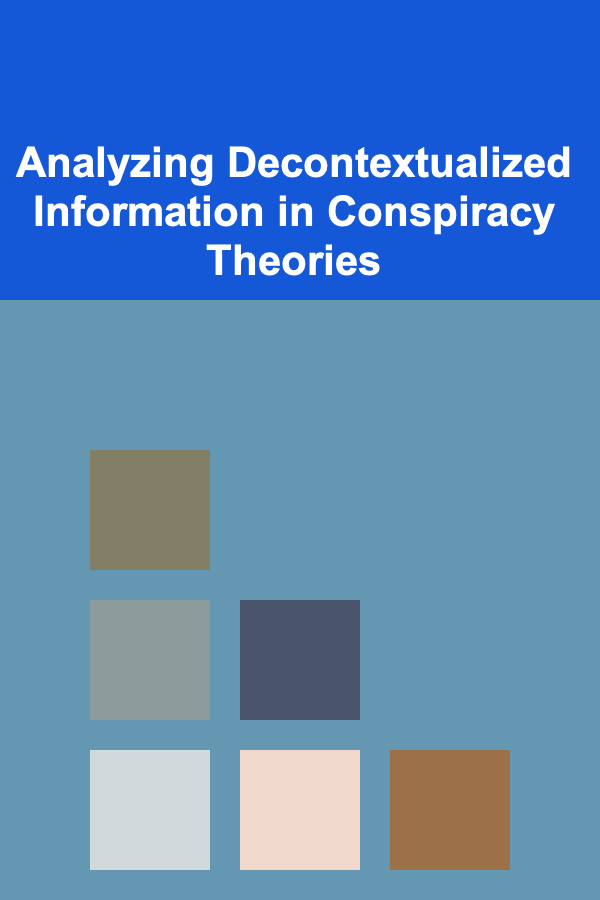
Analyzing Decontextualized Information in Conspiracy Theories
ebook include PDF & Audio bundle (Micro Guide)
$12.99$5.99
Limited Time Offer! Order within the next:

Conspiracy theories, narratives that attribute significant events to secret plots by powerful individuals or groups, are pervasive in contemporary society. While some might dismiss them as harmless fantasies, conspiracy theories can have significant real-world consequences, impacting political discourse, public health, and even inciting violence. A key tactic employed in the construction and propagation of these narratives is the manipulation and abuse of information through decontextualization. Understanding how this process works is crucial for critical analysis and effective counter-narrative strategies.
What is Decontextualization?
Decontextualization, in its simplest form, is the removal of information from its original context. This context can include the surrounding text, historical background, authorial intent, social circumstances, or any other relevant factors that contribute to a complete understanding of the information. When information is decontextualized, its meaning can be altered, distorted, or even completely reversed. It becomes susceptible to misinterpretation and can be used to support claims that are unsupported by the original source material.
Consider, for example, a quote from a historical figure discussing the need for strong national security measures during a period of heightened international tension. If this quote is presented without acknowledging the specific historical context, it could be misinterpreted as evidence of a long-standing conspiracy to undermine personal liberties, even if the historical figure's actual intentions were rooted in a desire to protect the nation from external threats.
How Decontextualization Fuels Conspiracy Theories
Conspiracy theories thrive on the strategic use of decontextualized information for several key reasons:
1. Creating False Connections and Associations
One of the primary ways decontextualization is employed is to create false connections between seemingly unrelated events or individuals. By selectively extracting specific details and stripping them of their surrounding context, conspiracy theorists can weave narratives that suggest hidden connections and coordinated actions where none exist. This is often achieved through:
- Selective Quotation: Picking and choosing specific phrases or sentences from longer texts, ignoring the overall argument or context.
- Juxtaposition: Placing unrelated pieces of information side-by-side to imply a causal relationship or a shared motive.
- Cherry-Picking Data: Focusing only on data that supports a pre-determined conclusion while ignoring contradictory evidence.
For example, a conspiracy theory about a global cabal might present a photograph of a meeting between two politicians and a businessman, claiming that they are secretly plotting to control the world's economy. The photograph itself provides no evidence of such a plot, but by removing it from its original context (e.g., a charity fundraising event) and juxtaposing it with other seemingly related pieces of information (e.g., quotes about global governance), the conspiracy theorist can create a narrative that appears to support their claim.
2. Exploiting Ambiguity and Uncertainty
Decontextualization is particularly effective when dealing with ambiguous or uncertain information. By removing the qualifying statements or nuances that would typically accompany such information, conspiracy theorists can present it as definitive proof of their claims. This is often seen in the interpretation of official documents, scientific studies, and news reports.
For instance, a government report on a public health crisis might acknowledge the possibility of multiple contributing factors. A conspiracy theorist could selectively quote the parts of the report that mention a specific cause, while ignoring the sections that discuss other potential factors or the limitations of the available data. This allows them to present the chosen cause as the sole or primary culprit, reinforcing their conspiracy narrative.
3. Manufacturing Doubt and Distrust
Another important function of decontextualization in conspiracy theories is to sow doubt and distrust in established institutions, experts, and sources of information. By selectively highlighting inconsistencies, errors, or ambiguities in official narratives, conspiracy theorists can undermine their credibility and create an environment in which alternative explanations seem more plausible. This is often achieved through:
- Misrepresenting Expert Opinions: Taking expert statements out of context to suggest that they support a conspiracy theory.
- Amplifying Contradictory Information: Highlighting minor inconsistencies in official accounts to cast doubt on the entire narrative.
- Attacking the Credibility of Sources: Dismissing information from established sources by claiming they are biased, corrupt, or controlled by the alleged conspirators.
For example, a conspiracy theory about a scientific consensus on climate change might focus on isolated cases of scientific misconduct or disagreements among researchers, while ignoring the overwhelming body of evidence that supports the consensus. By selectively highlighting these instances, the conspiracy theorist can create the impression that the scientific community is divided and that the consensus is based on flawed or manipulated data.
4. Reinforcing Existing Beliefs and Biases
Conspiracy theories often appeal to individuals who already hold certain beliefs or biases. Decontextualized information can be used to reinforce these pre-existing beliefs and biases, making the conspiracy theory seem more credible and appealing. This is often achieved through:
- Confirmation Bias: Seeking out and interpreting information in a way that confirms pre-existing beliefs.
- Emotional Appeals: Using emotionally charged language and images to evoke fear, anger, or distrust.
- Creating an "Us vs. Them" Mentality: Dividing the world into "insiders" who know the "truth" and "outsiders" who are being deceived.
For example, a conspiracy theory targeting a particular ethnic or religious group might selectively highlight negative stereotypes or historical grievances, while ignoring positive contributions or examples of cooperation. This reinforces existing prejudices and makes the conspiracy theory more appealing to individuals who already harbor negative feelings towards the targeted group.
Analyzing Decontextualized Information: A Practical Guide
Effectively analyzing the use of decontextualized information in conspiracy theories requires a critical and systematic approach. Here's a step-by-step guide:
1. Identify the Claim and the Supporting Evidence
The first step is to clearly identify the central claim being made by the conspiracy theory and the evidence that is presented to support it. This might involve summarizing the main arguments, identifying key figures and events, and noting any specific pieces of information that are cited as evidence.
Example: The conspiracy theory claims that a specific vaccine causes autism. The supporting evidence includes anecdotal reports of children developing autism after receiving the vaccine, and a retracted scientific study that suggested a link between the two.
2. Locate the Original Context of the Information
Once you have identified the supporting evidence, the next step is to locate the original context of that information. This might involve:
- Finding the original source of a quote: Reading the entire article, speech, or document from which the quote was taken.
- Reviewing the methodology of a study: Examining the research design, data analysis, and limitations of the study.
- Investigating the background of an event: Researching the historical, social, and political circumstances surrounding the event.
Example: Locate the original publication of the retracted scientific study on vaccines and autism. Read the retraction notice and understand the reasons for the retraction (e.g., data manipulation, flawed methodology).
3. Determine What Has Been Removed or Omitted
After you have located the original context of the information, carefully compare it to how it is presented in the conspiracy theory. Identify any information that has been removed, omitted, or altered in a way that changes its meaning or significance. This might involve:
- Identifying selective quotations: Noting any phrases or sentences that have been taken out of context.
- Recognizing omitted information: Identifying any relevant details or qualifications that have been left out.
- Detecting misrepresentations: Spotting any distortions or exaggerations of the original information.
Example: The conspiracy theory presents anecdotal reports of autism following vaccination without mentioning the overwhelming scientific consensus that there is no causal link. It ignores the fact that correlation does not equal causation and that many children develop autism around the same age they receive vaccinations regardless of vaccination status.
4. Analyze the Impact of Decontextualization
Once you have identified what has been removed or omitted, analyze the impact that this decontextualization has on the meaning and interpretation of the information. Ask yourself:
- How does the removal of this information change the meaning of the original source?
- Does the decontextualization create a false impression or mislead the audience?
- How does the decontextualization contribute to the overall narrative of the conspiracy theory?
Example: Removing the scientific context and focusing only on anecdotal reports creates a false impression that vaccines are dangerous and cause autism. This fuels fear and distrust in public health recommendations, potentially leading parents to avoid vaccinating their children.
5. Identify the Motives and Biases
Consider the potential motives and biases of the individuals or groups promoting the conspiracy theory. Ask yourself:
- What are their goals and objectives?
- What are their pre-existing beliefs and biases?
- How might these motives and biases influence their interpretation and presentation of information?
Example: The individuals promoting the vaccine conspiracy theory may have a distrust of government and pharmaceutical companies. They may also be motivated by a desire to promote alternative therapies or to gain attention and notoriety.
6. Provide Counter-Context and Recontextualization
The final step is to provide counter-context and recontextualize the information in a way that clarifies its true meaning and significance. This might involve:
- Presenting the full quote or source material in its original context.
- Providing relevant background information and historical context.
- Explaining the scientific consensus on the topic.
- Addressing the potential motives and biases of the conspiracy theorists.
Example: Present the overwhelming scientific evidence that refutes the link between vaccines and autism. Explain the rigorous testing and safety protocols involved in vaccine development. Highlight the public health benefits of vaccination and the risks of not vaccinating.
Examples of Decontextualization in Conspiracy Theories
Let's examine a few common examples of how decontextualization is used in specific conspiracy theories:
1. 9/11 Conspiracy Theories
9/11 conspiracy theories often rely on decontextualizing structural engineering principles and eyewitness testimonies. For example, the collapse of World Trade Center Building 7 is often attributed to a controlled demolition, with proponents selectively highlighting the speed and symmetry of the collapse. This ignores the extensive damage caused by debris from the collapse of the North Tower, as well as the office fires that burned for hours before the collapse. The official investigation concluded that the collapse was due to structural failure caused by these factors, a conclusion that is supported by a wealth of evidence.
2. Climate Change Denial
Climate change denial often involves cherry-picking data points to suggest that global warming is not occurring or is not caused by human activity. For example, deniers might focus on short-term temperature fluctuations to argue that the Earth is not warming, ignoring the long-term trend of rising global temperatures. They might also selectively highlight studies that question the role of human activity in climate change, while ignoring the overwhelming scientific consensus that supports anthropogenic climate change.
3. Flat Earth Theory
Flat Earth theorists often decontextualize scientific experiments and observations to support their claim that the Earth is flat. For example, they might selectively interpret the results of experiments designed to measure the curvature of the Earth, ignoring the explanations and corrections provided by scientists. They also often rely on anecdotal evidence and personal experiences to support their claims, while dismissing scientific evidence that contradicts their views.
4. Anti-Vaccine Movement
As mentioned previously, the anti-vaccine movement frequently uses decontextualized information to sow fear and distrust in vaccines. This includes selectively highlighting anecdotal reports of adverse reactions, misrepresenting scientific studies, and attacking the credibility of public health officials. By removing the scientific context and focusing on isolated cases of harm, the anti-vaccine movement creates a distorted picture of the risks and benefits of vaccination.
The Importance of Critical Thinking and Media Literacy
Combating the spread of conspiracy theories and the misuse of decontextualized information requires a strong foundation in critical thinking and media literacy. Individuals need to be able to:
- Evaluate sources of information: Assess the credibility and reliability of different sources, considering their potential biases and agendas.
- Distinguish between fact and opinion: Identify statements that are based on evidence and those that are based on personal beliefs or interpretations.
- Recognize logical fallacies: Identify common errors in reasoning, such as appeals to emotion, ad hominem attacks, and straw man arguments.
- Understand the scientific method: Appreciate the importance of evidence-based reasoning, peer review, and replication.
- Practice intellectual humility: Be willing to question their own beliefs and assumptions, and to consider alternative perspectives.
Furthermore, it is essential to promote media literacy education in schools and communities, empowering individuals to critically evaluate the information they encounter online and in the media. This includes teaching people how to identify fake news, detect misinformation, and assess the credibility of sources.
Conclusion
Decontextualization is a powerful tool that can be used to manipulate and distort information, fueling the spread of conspiracy theories and undermining trust in established institutions. By understanding how this process works and developing strong critical thinking skills, individuals can better evaluate the claims made by conspiracy theorists and make informed decisions based on evidence and reason. Analyzing the use of decontextualized information is not just an academic exercise; it is a crucial skill for navigating the complex information landscape of the 21st century and protecting ourselves from manipulation and misinformation.

How to Create a Checklist for Checking Your Car's Fluids
Read More
How to Nurture Relationships with Potential B2B Dropshipping Partners on LinkedIn
Read More
How to Use Lighting to Create a Balanced Home Office Space
Read More
How to Use Natural Elements in Your Holiday Home Decor
Read More
How to Plan Your Finances with a Monthly Planner
Read More
10 Tips for Using a Health Planner to Improve Sleep Habits
Read MoreOther Products

How to Create a Checklist for Checking Your Car's Fluids
Read More
How to Nurture Relationships with Potential B2B Dropshipping Partners on LinkedIn
Read More
How to Use Lighting to Create a Balanced Home Office Space
Read More
How to Use Natural Elements in Your Holiday Home Decor
Read More
How to Plan Your Finances with a Monthly Planner
Read More